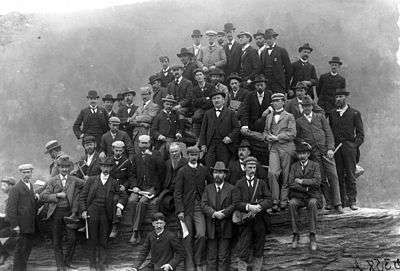Geological Society of America

The Geological Society of America (GSA) is a nonprofit organization dedicated to the advancement of the geosciences.
History
The society was founded in New York in 1888 by Alexander Winchell, John J. Stevenson, Charles H. Hitchcock, John R. Procter and Edward Orton[1] and has been headquartered at 3300 Penrose Place, Boulder, Colorado, USA, since 1968.
The society has six regional sections in North America, an international section, and seventeen specialty divisions.
GSA began with 100 members under its first president, James Hall. Over the next 43 years it grew slowly but steadily to 600 members until 1931, when a $4 million endowment from 1930 president R.A.F. Penrose, Jr. jumpstarted the GSA's growth. As of April 2013, GSA has more than 25,000 members in over 100 countries.
Activities
The stated mission of GSA is "to advance geoscience research and discovery, service to society, stewardship of Earth, and the geosciences profession". Its main activities are sponsoring scientific meetings and publishing scientific literature, particularly the journals Geological Society of America Bulletin (commonly called "GSA Bulletin") and Geology. A more recent publication endeavor is the online-only journal Geosphere. In February 2009, GSA began publishing Lithosphere. GSA's monthly news and science magazine, GSA Today, is open access online.
Annual meetings
Recent meetings include:[2]
- 2015 Baltimore, Maryland, 1-4 November
- 2014 Vancouver, British Columbia, Canada: 19–22 October
- 2013 Denver, Colorado: 27–30 October
- 2012 Charlotte, North Carolina: 4–7 November
Annual meetings consist of oral and poster presentations about geology, along with field trips, short courses, and other activities. Another big part of the annual meeting is the Exhibit Hall, which includes the Graduate School Information Forum and booths for companies, suppliers, other geoscience organizations, and purveyors of goods and services.
Position statements
As the need arises, GSA issues Position Statements "in support of and consistent with the GSA's Vision and Mission to develop consensus on significant professional, technical, and societal issues of relevance to the geosciences community. Position Statements, developed and adopted through a well-defined process, provide the basis for statements made on behalf of the GSA before government bodies and agencies and communicated to the media and the general public."[3]
For example, in 2006, the GSA adopted the Position Statement Global Climate Change:
- The Geological Society of America (GSA) supports the scientific conclusions that Earth’s climate is changing; the climate changes are due in part to human activities; and the probable consequences of the climate changes will be significant and blind to geopolitical boundaries. Furthermore, the potential implications of global climate change and the time scale over which such changes will likely occur require active, effective, long-term planning.
- Current predictions of the consequences of global climate change include: (1) rising sea level, (2) significant alteration of global and regional climatic patterns with an impact on water availability, (3) fundamental changes in global temperature distribution, (4) melting of polar ice, and (5) major changes in the distribution of plant and animal species. While the precise magnitude and rate of climate change cannot be predicted with absolute certainty, significant change will affect the planet and stress its inhabitants.[4]
Past presidents
Past presidents of the Geological Society of America [5]
See also
References
- ↑ Editor (26 August 1938) "The Semi-Centennial Meeting of the Geological Society of America" Science (New Series) 88(2278): p. 183
- ↑ "Meetings". Geological Society of America. Retrieved 2015-09-20.
- ↑ GSA Position Statements
- ↑ Global Climate Change
- ↑ The Geological Society of America